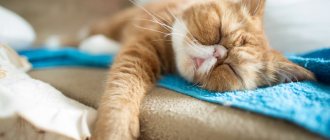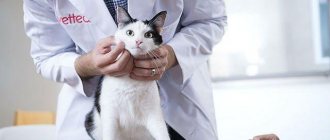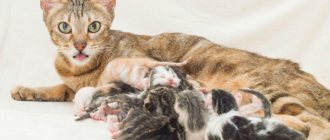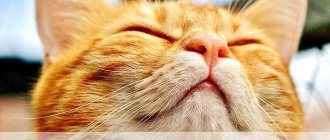What will you learn from the article?
- Causes of runny nose (rhinitis) in cats
- Symptoms of feline rhinitis
- How to treat a runny nose in a cat Folk remedies
A runny nose in a cat is not an independent disease, it is a sign of many diseases, which can include both mild ailments and serious and dangerous pathologies. The sense of smell is the most important sense for cats, so as soon as you notice your pet has a runny nose, congestion, difficulty breathing or discharge from the nostrils, contact your veterinarian immediately.
Cat anatomy means they have very narrow nasal passages, so even a small amount of swelling can cause complete nasal congestion. A stuffy nose will not be able to perform its functions: warm and clean the inhaled air. Less oxygen will reach the brain, and the cat may become hypothermic.
Reasons why a cat has a cold
Knowing the reasons why the cat caught a cold , the owner has the opportunity to protect the cat from the disease. Colds that cats can get have different causes. Which ones we will look at below.
living conditions - this factor greatly influences the occurrence of colds in your pet. It often happens when, having adopted a cat, people simply do not know how to treat it. They believe that she will feel good in any conditions. This is wrong. Keeping a cat requires certain conditions that must be adhered to, taking into account breed characteristics, climatic conditions, etc. The animal must not be allowed to become hypothermic. An atmosphere that is too humid can cause pneumonia. A lot of nuances must be taken into account. For detailed information on keeping cats, you can contact our veterinary center;
nutrition is also an important factor. The animal's nutrition must be complete and balanced. Often, due to the lack of vitamins and microelements, the animal’s immunity decreases and the body becomes an open target for attack by viruses and infections;
temperature change - the cat’s body, despite its predatory origin, is very sensitive to temperature changes. On hot summer days, you should keep the room temperature at about 19-20 degrees, and on cold winter days at about 24 degrees. It is very important
!
Hypothermia - situations here can be different. Sometimes, after the owners bathe the cat, they finish the procedure without drying its fur, but in vain. There may be a draft in the room and the pet may get sick. Another situation is when your cat likes to walk outside and you welcome it, he may get caught in the rain and also become hypothermic, which is fraught with a cold;
other diseases - very often, various ailments that occur without any symptoms can weaken the animal’s immunity.
Is it dangerous! Since latent pathology can develop aggressively against the background of a cold, the animal’s body takes a double blow to its health.
Prevention
A cold is not dangerous for an animal with normal immunity, but the disease causes discomfort to the cat and is quite difficult to treat. It is much easier to prevent infection. The following measures help with this:
- Proper care of animals. For the first few weeks of life, kittens should be kept in a warm, draft-free room. Trays and sleeping places for adult animals should also not be in rooms with cold air.
- Gradual adaptation to the street. You need to start this procedure in the warm season. The cat is allowed outside for several hours. In this case, you need to ensure that the animal does not become hypothermic. In rainy and windy weather, walks are avoided.
- Proper bathing. The cat needs to be bathed with warm water. After the procedure, the fur is thoroughly dried with a towel, while the pet should be in a warm room.
- Proper nutrition. The diet should include balanced food and sufficient fluids. Do not give your cat cold food or water.
Cats with a compromised immune system are susceptible to colds, so you need to take care to increase the body's defenses. Vitamin supplements selected by a veterinarian help with this. Vaccination also helps protect your cat from diseases.
Can a cat catch a cold? What are the first symptoms?
Colds are usually caused by exposure to viruses. This type of disease is characterized by certain symptoms that are easy to notice in your pet . If your cat has a cold , you need to pay attention to its behavior
.
Knowing the signs of a cold in cats , it becomes possible to quickly respond to their manifestations and seek help from a veterinary center. This will avoid complications and deterioration of the pet’s condition.
- So, here are the main symptoms of colds in cats:
- apathy and weakness - a cat is not the most active representative of the fauna and loves to lie in its favorite place. This lazy pet behavior is normal. But when the animal does not react in any way to your attempt to play with it and practically does not move from its place, it is worth thinking about;
- Nasal discharge - colds in cats may be accompanied by characteristic nasal discharge. Along with them, bad enzymes and microorganisms leave the animal’s body. The discharge itself has a transparent color and a viscous consistency. But if they take on the hue of purulent discharge mixed with blood, you urgently need to seek help from a veterinarian, this is a dangerous sign;
- sneezing and coughing - by coughing and sneezing, the cat clears its airways. If you cough frequently, you should make sure that there are no foreign bodies in the respiratory tract that make breathing difficult;
- discharge from the eyes;
- loss of appetite - during the course of the disease, intoxication occurs. It is characterized by decreased appetite. A cat may not eat well, but it should drink as much as it needs. Therefore, the bowl of water should always be full and the contents clean. If loss of appetite lasts more than 36 hours, you should take the animal to the veterinarian and describe the change in its behavior;
- inflammation of the mucous membranes - this symptom is not typical for all cats. Basically, the redness of the mucous membranes in an animal depends on the characteristics of the breed. In some cases, it may indicate a change in blood pressure;
- increase in body temperature - if the cat is lethargic, and the thermometer readings show significant deviations from the norm, you should start to worry. High body temperature may indicate an inflammatory process in the body.
If you notice one of the symptoms of a cold, do not delay and immediately contact a veterinary center for help. Our specialists will arrive within 40 minutes and will provide all the necessary measures.
Diseases of cats with “cold” symptoms
Infectious diseases:
- Rhinotracheitis (feline herpesvirus)
- Calcevirosis
- Chlamydia
- Mycoplasmosis
- Bordetellosis
Non-communicable diseases:
- Allergy
- Bronchial asthma
- Mechanical rhinitis (foreign bodies entering the respiratory tract - most often dust particles and small plant seeds)
- Neoplasms in the nasal cavity and upper respiratory tract
The appearance of signs of a cold should not go unnoticed by the animal owner. Often, the animal may self-heal, or the disease will enter a chronic stage without the manifestation of clinical symptoms. In young, weakened and unvaccinated animals, serious complications, even death, are common.
Diagnostics:
Before prescribing treatment, the attending physician must conduct a diagnosis of the cat’s body to identify the exact cause of the disorder. The fact is that the symptoms of colds are similar to other pathologies in animals. It is very important to exclude the occurrence of dangerous diseases and make an accurate diagnosis
. To ensure that the research result is accurate, certain measures are taken. Let's look at the most basic of them:
- initial examination by a veterinarian - involves a visual assessment of the patient’s condition. It is necessary to give the doctor detailed information about the change in the pet’s condition and its actions over the last 72 hours;
- blood test - biochemical and general analysis of blood cells allows doctors to determine the condition of the body and internal organs as a whole;
- Ultrasound examination and radiography - these procedures are prescribed additionally if the situation requires it.
Treatment of non-communicable diseases
Treatment of non-infectious respiratory diseases depends on their origin.
- For feline asthma, it is necessary, if possible, to identify allergens, exclude the animal’s contact with them, and use hormonal steroid drugs in the treatment regimen.
- In case of mechanical rhinitis, it is necessary to remove the foreign object from the nasopharynx and, if necessary, connect to the sanitation of the nasal cavity.
- In case of neoplasms, it is necessary to remove the tumor and carry out further supportive therapy for the animal. With your doctor, assess the risks and quality of life of your pet if additional diagnostics show that the tumor affects other vital organs and tissues, or has metastasized to vital organs.
For any respiratory disease, the main key to success is the timely provision of qualified veterinary care.
Treatment of colds in cats
How to treat colds in cats , what to do? After diagnosis, the doctor must prescribe competent treatment aimed at combating the disease. Taking antibiotics and stronger drugs is not necessary. If a cat has a common cold, the doctor only prescribes following the recommendations throughout the course of the disease.
- Main treatment steps:
- the room where the animal is located must be dry and regularly ventilated;
- the animal is entitled to rest;
- there should always be warm water or milk in the bowl;
- in case of chills, cover the animal with a blanket;
- If there is excessive discharge from the nose and eyes, you should wipe it with a cotton swab.
Follow your doctor's instructions and monitor your pet's health. If the cat's health does not improve, contact the veterinary center again. Under no circumstances should you try to cure your pet yourself by self-medicating. This event can lead to a deterioration in the animal’s condition, as well as provoke the appearance of other diseases!
Prevention:
Better than any treatment is the absence of disease.
Preventive measures aimed at strengthening the cat’s immunity can become a powerful weapon in the hands of every owner . With their help, you can prevent the occurrence of many diseases. Preventive measures usually consist of recommendations from leading veterinarians. Let's look at some of them so that the cat doesn't catch a cold .
- Here are some requirements that must be observed when keeping cats:
- nutrition – your furry friend’s diet should be complete and balanced. The food must contain all the necessary vitamins, minerals and trace elements. You should not feed your animal expired food or allow it to rummage through food waste. If the animal is walking on the street, you need to teach the pet not to eat anything other than homemade food;
- conditions - in order for the cat to feel comfortable and healthy, it is necessary to provide it with certain conditions during its maintenance. The air temperature should be different at certain times of the year. The bedding on which the animal lies must be promptly cleaned and disinfected. When bathing, it is necessary to exclude the cat from being in a draft;
- visit to the veterinarian - in order to ensure good health for your pet, it is necessary to visit a veterinarian in a timely manner. This will prevent the occurrence of many diseases, as well as detect dangerous diseases at an early stage, which will help carry out treatment more successfully;
- other diseases - during the course of any disease, you cannot leave everything to chance. Any pathology weakens the pet’s immunity and can cause complications.
Treatment of infectious respiratory diseases
The key to successful treatment of infectious diseases is an individual approach to each animal. However, there is a general scheme for the treatment of respiratory infections.
- Specific therapy
- if the pathogen is identified, drugs are prescribed to which a particular microorganism is sensitive (for example, doxycycline for chlamydial infection) - If the disease is caused by a virus that (like all viruses) does not respond to targeted treatment, antibiotic therapy is usually still necessary.
In addition to the viruses themselves, the primary pathogens, secondary opportunistic microflora play a significant role in respiratory diseases. The use of antibiotics in the treatment of infectious diseases stops the increased growth of bacteria that are on the surface of your pet's respiratory tract and prevents the development of complications, thereby giving the body time to fight the primary pathogen. - Symptomatic therapy
is necessary to maintain the animal’s body during illness. The variability of symptoms is high, so this may include painkillers, antipyretics, hemostatic drugs, as well as local sanitation of the nasal passages and treatment of the oral cavity.
Runny nose in kittens
An imperfect immune system leads to the frequent occurrence of rhinitis in kittens. The causes may be hypothermia or allergies. Weakened kittens get sick more often due to crowded living conditions and poor nutrition. Obstruction of narrow nasal passages causes suffering to babies.
If the animal’s condition is satisfactory, wash the nasopharynx using a syringe without a needle with a solution of salt, soda or tannin. Drops for adult cats are not suitable for kittens; Aquamaris, Pinosol, Protargol are used. The nose area is heated with bags of salt or sand. To improve immunity, you need a balanced diet rich in vitamins.
It is necessary to exclude viral infections with symptoms of a runny nose, which cause high mortality among small pets. Calcivirosis—30%, Rhinotracheitis—30%, Panleukopenia—50%. Avoiding contact with sick animals does not protect kittens from disease. With panleukopenia, intrauterine infection is possible.
In the first 8 weeks of life, it is necessary to immunize with the following drugs: Multifel-4, Nobivak, Tricat, Quadricat. A week before vaccination, treatment with anthelmintic drugs is required.
In the future, the vaccination schedule should be strictly followed to create lasting lifelong immunity. A domestic cat can also become infected; the virus can be brought from the street on shoes or outerwear. Correctly carried out prevention will protect your cat from dangerous diseases.
The most dangerous diseases
A runny nose is a symptom of the most dangerous viral diseases:
- Calcivirosis.
- Rhinotracheitis.
- Panleukopenia.
Calcivirosis
An extremely contagious viral infection. Characterized by fever, rhinitis and stomatitis. Kittens taken from their mothers become ill.
recommended articles:
- Pneumonia in cats
- Calicivirus infection in cats
Those who recover gain lifelong immunity, but become spreaders of the virus. If the disease is not treated, 30% of clinically ill patients die.
Ulcerative stomatitis is considered a striking additional symptom. This makes it difficult for the kitten to swallow. He refuses to eat and loses weight. Gingivitis occurs, characterized by inflammation of the gums. A runny nose is accompanied by a cough, and bronchopneumonia develops. If pulmonary edema occurs, the kitten dies.
Rhinotracheitis
Rhinotracheitis is caused by the herpes virus. Develops rhinitis, conjunctivitis and tracheitis. The kitten cries and sneezes, having recovered from the disease, it becomes a carrier of the virus, gaining lifelong immunity. Hypothermic cubs and unvaccinated individuals become ill. Unbalanced nutrition and overcrowding increases the risk of epizootics.
The signs of the disease are similar to the symptoms of Calcivirosis, but the ulcers do not appear on the mucous membrane of the mouth, but on the cornea of the eye. In kittens, necrosis of nasal tissue and bone resorption are observed.
Rhinotracheitis
Panleukopenia
Panleukopenia is a dangerous disease with high mortality. Survivors within 100 hours become reservoirs of Parvovirus. Contagium is transmitted by blood-sucking exoparasites.
There is no placental barrier; kittens receive the virus in utero. Intermittent fever is characteristic. First, body temperature rises 2 °C above normal, and after 2 days it drops 1 °C below the limit.
The pulmonary variant of panleukopenia is characterized by purulent discharge from wear and tear and eyes. Cloudy films and hemorrhages appear on the mucous membranes. The mortality rate is, on average, 50%.
Panleukopenia











